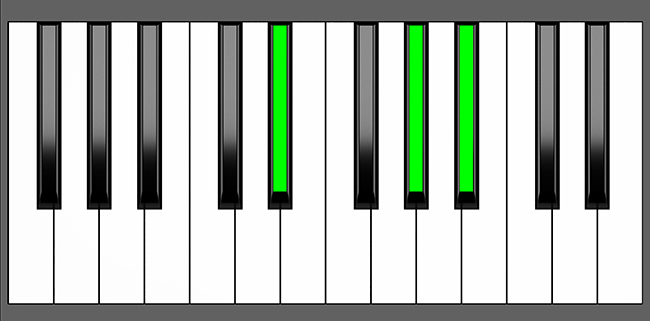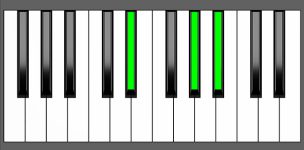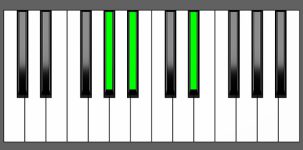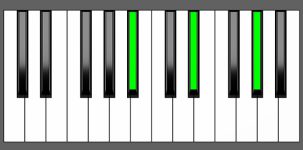Piano Diagram of Ebsus4 in Root Position

The Eb suspended fourth (Ebsus4) chord consists of three notes: Eb, Ab, and Bb. It’s called a “suspended 4” chord because the third note of the chord is replaced with a perfect fourth. To play the Ebsus4 chord on a piano, you would start with an Eb major chord and replace the third note G, with the fourth note Ab. Further reading will give you a better understanding of the music theory principles behind this chord.
Structure of Ebsus4
Notes |
|---|
| Eb, Ab, Bb |
Intervals |
|---|
| R, 4, 5 |
Fingers Position
Left Hand |
|---|
| 3, 2, 1
4, 2, 1 |
Right Hand |
|---|
| 1, 2, 4
1, 3, 4 |
Ebsus4 Chord Inversions
The Ebsus4 chord has a total of 2 inversions:
| Root Position: | Eb | Ab | Bb |
| 1st Inversion: | Ab | Bb | Eb |
| 2nd Inversion: | Bb | Eb | Ab |
Piano Keyboard Diagrams
Ebsus4 Chord Equivalencies
An interesting detail about sus4 chords is that their 1st inversion results in a sus2 chord. To clarify, when the 4th note of a sus4 chord becomes the root note, it transforms into a sus2 chord.
1st Inversion of Ebsus4 = Absus2
For instance, if we take the Ebsus4 chord with the notes Eb, Ab, and Bb and rearrange them so that Ab becomes the root note, we end up with an Absus2 chord with the notes Ab, Bb, and Eb. Therefore, the 1st inversion of Ebsus4 is equivalent to Absus2.
Music Theory and Harmony of Ebsus4
What are Suspended Chords?
Suspended chords are a type of chord in which the third note is replaced by either a major second or a perfect fourth. These resulting chords are called suspended second (sus2) or suspended fourth (sus4) chords, respectively. These chords create a unique and sometimes unresolved sound that can add tension and interest to a musical composition.
Suspended chords have a distinct sound that sets them apart from major and minor chords. They are called suspended chords because they temporarily suspend the listener’s expectation of hearing a major or minor stable chord. Instead, they feature a perfect fourth or major second interval in place of the third. Due to their “neutral nature,” suspended chords can sometimes be used as substitutes for both major and minor chords.
Building the Ebsus4 Chord: Different Approaches
Starting from the Eb Major Scale
To build a sus4 chord, you can use the major scale as a guide and combine a root note, a perfect 4th interval, and a perfect 5th interval.


To create an Ebsus4 chord, apply the formula R, 4, 5 in the following manner:
- Begin with the Root note, which is Eb.
- Select the 4th interval, which is Ab, and add it to the chord.
- Finally, add the 5th interval, which is Bb.
By following this simple formula, you can create a sus4 chord from any major scale.
by Combining Intervals
One method to create a suspended 4th chord is by combining two specific intervals – a perfect 4th, and a major 2nd.
4 + 2 = sus4 Chords
To illustrate, let’s use the Ebsus4 chord as an example. By examining the intervals between the notes, we can see that Eb-Ab forms a perfect 4th interval, and Ab-Bb creates a major second interval (a whole tone).
How to Use Ebsus4 in a Chord Progression
Suspended chords have a unique quality that sets them apart from major and minor chords. They are considered neither major nor minor, which makes them a great tool for creating tension and suspense in a musical composition before resolving to a stable major or minor chord.
In the following tables, you will find the harmonization of the major and relative natural minor scales for keys that include Eb major and Eb minor chords in various positions and different harmonic roles.
Ebsus4 as Substitute of Eb Maj Chords
In the key of Bb Major and G minor, the 4th note Ab can clash with the G and the natural A notes that are present in those keys. While this doesn’t prevent you from using the Ebsus4 chord in those positions, it’s important to be aware that it can create a strong dissonance with the melody or other elements of the composition.
on Major Scales
| Major Scales | I | ii | iii | IV | V | vi | vii |
|---|---|---|---|---|---|---|---|
| Eb | Eb Maj7 ⇒ Ebsus4 | F min7 | G min7 | Ab Maj7 | Bb Maj7 | C min7 | Dm7b5 |
| Bb | Bb Maj7 | C min7 | D min7 | Eb Maj7 ⇒ Ebsus4 | F Maj7 | G min7 | Am7b5 |
| Ab | Ab Maj7 | Bb min7 | C min7 | Db Maj7 | Eb7 ⇒ Ebsus4 | F min7 | Gm7b5 |
- Tonic chord in Eb Major
- Non Diatonic Subdominant chord in Bb Major
- Dominant chord in Ab Major
on Natural minor Scales
| Minor Scales | i | ii | III | iv | v | VI | VII |
|---|---|---|---|---|---|---|---|
| C | C min7 | Dm7b5 | Eb Maj7 ⇒ Ebsus4 | F min7 | G min7 | Ab Maj7 | Bb7 |
| G | G min7 | Am7b5 | Bb Maj7 | C min7 | D min7 | Eb Maj7 ⇒ Ebsus4 | F7 |
| F | F min7 | Gm7b5 | Ab Maj7 | Bb min7 | C min7 | Db Maj7 | Eb7 ⇒ Ebsus4 |
- Mediant chord in C minor
- Non Diatonic Submediant chord in G minor
- Leading tone chord in F minor
Ebsus4 as Substitute of Eb min Chords
While the Ebsus4 chord can be used as a substitute or variation for Eb minor 7th chords, it’s important to note that an Eb7sus4 chord would be a better fit due to the presence of the minor 7th.
on Major Scales
| Major Scales | I | ii | iii | IV | V | vi | vii |
|---|---|---|---|---|---|---|---|
| Db | Db Maj7 | Eb min7 ⇒ Ebsus4 | F min7 | Gb Maj7 | Ab7 | Bb min7 | Cm7b5 |
| Cb = B | B Maj7 | C# min7 | D# min7 ⇒ D#sus4 = Ebsus4 | E Maj7 | F#7 | G# min7 | A#m7b5 |
| Gb | Gb Maj7 | Ab min7 | Bb min7 | Cb Maj7 | Db7 | Eb min7 ⇒ Ebsus4 | Fm7b5 |
- Supertonic chord in Db Major
- Mediant chord in B Major scale as D#sus4
- Submediant chord in Gb Major scale
on Natural minor Scales
| Minor Scales | i | ii | III | iv | v | VI | VII |
|---|---|---|---|---|---|---|---|
| Eb | Eb min7 ⇒ Ebsus4 | Fm7b5 | Gb Maj7 | Ab min7 | Bb min7 | Cb Maj7 | Db7 |
| Bb | Bb min7 | Cm7b5 | Db Maj7 | Eb min7 ⇒ Ebsus4 | F min7 | Gb Maj7 | Ab7 |
| Ab | Ab min7 | Bbm7b5 | Cb Maj7 | Db min7 | Eb min7 ⇒ Ebsus4 | Fb Maj7 | Gb7 |
- Tonic chord in Eb minor
- Subdominant chord in Bb minor
- Dominant chord in Ab minor
Ebsus4 Function in Major and Minor Keys
Understanding Scale Degrees
Scale degrees are essential for understanding the relationship between the notes in a scale and how they function within chords. The diatonic major scale consists of seven degrees, each with its unique role in creating the overall harmony of the scale.
- The first degree of the scale is known as the Tonic, which serves as the anchor for the music. It establishes a stable tonal center that acts as the foundation for the scale.
- The second degree is called the Supertonic, often used as a transitional note between the Tonic and other notes in the scale. It creates a sense of motion within the melody or harmony.
- The third degree of the scale is the Mediant, which sits halfway between the Tonic and Dominant notes. It helps establish whether the scale is major or minor.
- The fourth degree is called the Subdominant, used to complement the Dominant and add tension and resolution to the music.
- The fifth degree is the Dominant, which creates tension and anticipation within the melody or harmony, typically resolved by returning to the Tonic.
- The sixth degree is the Submediant, often employed as a transitional note between the Dominant and Tonic, adding a sense of stability and restfulness to the music.
- The seventh degree is the Leading tone, located one half-step below the Tonic. It creates a strong sense of tension and a desire to resolve to the Tonic, frequently used to create a sense of resolution and finality in the melody or harmony.
Ebsus4 in Eb Major
The Ebsus4 chord can be used along with the Eb Maj7 chord (or any other kind of Eb major chord) to add color on the first degree. The Ebsus4 chord can suspend the Eb Major chord or the subsequent chord.
| I | ii | iii | IV | V | vi | vii |
| Eb Maj7 | F min7 | G min7 | Ab Maj7 | Bb7 | C min7 | Dm7b5 |
Ebsus4 Chord Progressions as I degree
ii V I
| ii | V | I |
| F min7 | Bb7 | Ebsus4 | Eb Maj7 |
I IV V
| I | IV | V |
| Ebsus4 | Eb Maj7 | Ab Maj7 | Bb7 |
I V vi IV
| I | V | vi | IV |
| Ebsus4 | Eb Maj7 | Bb7 | C min7 | Ab Maj7 |
I IV vi V
| I | IV | vi | V |
| Ebsus4 | Eb Maj7 | Ab Maj7 | C min7 | Bb7 |
Ebsus4 in Bb Major (Non Diatonic)
Let’s explore the sound of the Ebsus4 chord in the key of Bb major, which can be used as a substitute or variation of the Eb Maj7 chord on the IV degree. However, it’s important to note that the Ebsus4 contains an Ab which clashes with the G and the A present in this key. So, since the Ebsus4 is not diatonic in this key, it may sound unusual or foreign to the overall tonality.
| I | ii | iii | IV | V | vi | vii |
| Bb Maj7 | Cm7b5 | D min7 | Eb Maj7 | F7 | G min7 | Am7b5 |
Ebsus4 Chord Progressions as IV degree
I IV V
| I | IV | V |
| Bb Maj7 | Ebsus4 | Eb Maj7 | F7 |
I V vi IV
| I | V | vi | IV |
| Bb Maj7 | F7 | G min7 | Ebsus4 | Eb Maj7 |
I IV vi V
| I | IV | vi | V |
| Bb Maj7 | Ebsus4 | Eb Maj7 | G min7 | F7 |
Ebsus4 in Ab Major
In the key of Ab Major, the fifth degree it features an Eb7 chord. Adding an Ebsus4 chord can create tension and expectation, leading to a resolution on the dominant chord. Note that using an Eb7sus4 chord instead of an Ebsus4 would be a better option in this case.
| I | ii | iii | IV | V | vi | vii |
| Ab Maj7 | Bb min7 | C min7 | Db Maj7 | Eb7 | F min7 | Gm7b5 |
Ebsus4 as V degree – Chord Progressions
ii V I
| ii | V | I |
| Bb min7 | Ebsus4 | Eb7 | Ab Maj7 |
I IV V
| I | IV | V |
| Ab Maj7 | Db Maj7 | Ebsus4 | Eb7 |
I V vi IV
| I | V | vi | IV |
| Ab Maj7 | Ebsus4 | Eb7 | F min7 | Db Maj7 |
I IV vi V
| I | IV | vi | V |
| Ab Maj7 | Db Maj7 | F min7 | Ebsus4 | Eb7 |
I IV ii V iii vi ii V
| I | IV | ii | V | iii | vi | ii | V |
| Ab Maj7 | Db Maj7 | Bb min7 | Ebsus4 | Eb7 | C min7 | F min7 | Bb min7 | Ebsus4 | Eb7 |
Ebsus4 in C Minor
Try experimenting with chord progressions featuring an Eb Maj7 on the III degree of the C minor scale, and try playing an Ebsus4 before or after the Eb Maj7 to see how it sounds.
| i | ii | III | iv | v | VI | VII |
| C min7 | Dm7b5 | Eb Maj7 | F min7 | G min7 | Ab Maj7 | Bb7 |
Ebsus4 Chord Progressions as III degree
i III
| i | III |
| C min7 | Ebsus4 | Eb Maj7 |
i III VII VI
| i | III | VII | VI |
| C min7 | Ebsus4 | Eb Maj7 | Bb7 | Ab Maj7 |
i III iv v
| i | III | iv | v |
| C min7 | Ebsus4 | Eb Maj7 | F min7 | G min7 |
i III ii v
| i | III | ii | v |
| C min7 | Ebsus4 | Eb Maj7 | Dm7b5 | G min7 |
I iii vi V
| i | III | VI | iv |
| C min7 | Ebsus4 | Eb Maj7 | Ab Maj7 | F min7 |
Circle Progression
| i | iv | VII | III | VI | ii | V7 | i |
| C min7 | F min7 | Bb7 | Ebsus4 | Eb Maj7 | Ab Maj7 | Dm7b5 | G7 | C min7 |
Ebsus4 in G Minor (Non Diatonic)
In the key of G minor, the VI degree chord is an Eb major chord. To add some color, you can use an Ebsus4 chord as a substitution or variation of this chord. However, keep in mind that the Ebsus4 chord is non-diatonic in this key because it contains an A-flat while the G minor scale contains a G and an A. Therefore, it’s generally recommended to avoid using the Ebsus4 chord in this key but feel free to experiment and see how it sounds to your ears.
| i | ii | III | iv | v | VI | VII |
| G min7 | Am7b5 | Bb Maj7 | C min7 | D min7 | Eb Maj7 | F7 |
Ebsus4 Chord Progressions as VI degree
i VI VII
| i | VI | VII |
| G min7 | Ebsus4 | Eb Maj7 | F7 |
i v VI VII
| i | v | VI | VII |
| G min7 | D min7 | Ebsus4 | Eb Maj7 | F7 |
i III VII VI
| i | III | VII | VI |
| G min7 | Bb Maj7 | F7 | Ebsus4 | Eb Maj7 |
Circle Progression
| i | iv | VII | III | VI | ii | V7 | i |
| G min7 | C min7 | F7 | Bb Maj7 | Ebsus4 | Eb Maj7 | Am7b5 | D7 | G min7 |
Ebsus4 in F Minor
Let’s explore the use of Ebsus4 as a leading tone chord in the key of F minor. As the leading tone chord, Ebsus4 can create tension and lead the listener’s ear to the tonic chord, which is F minor in this case.
| i | ii | III | iv | v | VI | VII |
| F min7 | Gm7b5 | Ab Maj7 | Bb min7 | C min7 | Db Maj7 | Eb7 |
Ebsus4 as VII degree – Chord Progressions
i VI VII
| i | V | VII |
| F min7 | C min7 | Ebsus4 | Eb7 |
i v VI VII
| i | v | VI | VII |
| F min7 | C min7 | Db Maj7 | Eb7 | Ebsus4 |
i III VII VI
| i | III | VII | VI |
| F min7 | Ab Maj7 | Ebsus4 | Eb7 | Db Maj7 |
Circle Progression
| i | iv | VII | III | VI | ii | V7 | i |
| F min7 | Bb min7 | Ebsus4 | Eb7 | Ab Maj7 | Db Maj7 | Gm7b5 | C7 | F min7 |
Ebsus4 in Db Major
In the key of Db Major, the supertonic chord is an Eb minor. However, we can use an Ebsus4 chord as a variation or substitution for the Ebm chord to add some tonal color and interest to a chord progression.
| I | ii | iii | IV | V | vi | vii |
| Db Maj7 | Eb min7 | F min7 | Gb Maj7 | Ab7 | Bb min7 | Cm7b5 |
Ebsus4 Chord Progressions as ii degree
ii V I
| ii | V | I |
| Ebsus4 | Ebm7 | Ab7 | Db Maj7 |
I IV ii V iii vi ii V
| I | IV | ii | V | iii | vi | ii | V |
| Db Maj7 | Gb Maj7 | Ebsus4 | Ebm7 | Ab7 | F min7 | Bb min7 | Ebm7 | Ebsus4 | Ab7 |
Ebsus4 in Cb Major
Check D#sus4 in B Major
Ebsus4 in Gb Major
Let’s explore how the Ebsus4 chord can function as a submediant chord in the key of Gb major. You can try incorporating it into chord progressions that feature an Ebm chord on the VI degree.
| I | ii | iii | IV | V | vi | vii |
| Gb Maj7 | Ab min7 | Bb min7 | Cb Maj7 | Db7 | Eb min7 | Fm7b5 |
Ebsus4 as vi degree – Chord Progressions
I iii vi V
| I | iii | vi | V |
| Gb Maj7 | Bb min7 | Ebsus4 | Ebm7 | Db7 |
I vi ii V
| I | vi | ii | V |
| Gb Maj7 | Ebsus4 | Ebm7 | Ab min7 | Db7 |
I IV ii V iii vi ii V
| I | IV | ii | V | iii | vi | ii | V |
| Gb Maj7 | Cb Maj7 | Ab min7 | Db7 | Bb min7 | Ebsus4 | Ebm7 | Ab min7 | Db7 |
Ebsus4 in Eb Minor
When using the Ebsus4 chord in the key of Eb minor, it can be a great variation for the traditional Ebm chord. It creates a more ambiguous sound due to its suspended nature, but it can be used to add tension to a chord progression.
| i | ii | III | iv | v | VI | VII |
| Eb min7 | Fm7b5 | Gb Maj7 | Ab min7 | Bb min7 | Cb Maj7 | Db7 |
Ebsus4 Chord Progressions as i degree
i VI VII
| i | VI | VII |
| Ebsus4 | Ebm7 | Cb Maj7 | Db7 |
Modulation
| isus4 | i | isus2 | i |
| Ebsus4
Eb (Bb, Eb, Ab) |
Eb min
Eb (Bb, Eb, Gb) |
Ebsus2
Eb (Bb, Eb, F) |
Eb min
Eb (Bb, Eb, Gb) |
Use your left hand to play the Eb root note, and your right hand to play the remaining notes of the chord.
i iv VI VII
| i | iv | VI | VII |
| Ebsus4 | Ab min7 | Cb Maj7 | Db7 |
Ebsus4 in Bb Minor
In Bb minor, the IV degree is Eb major, which can be replaced or varied with an Ebsus4 chord.
| i | ii | III | iv | v | VI | VII |
| Bb min7 | Cm7b5 | Db Maj7 | Eb min7 | F min7 | Gb Maj7 | Ab7 |
Ebsus4 Chord Progressions as iv degree
iv III VI VII
| iv | III | VI | VII |
| Ebsus4 | Ebm7 | Db Maj7 | Gb Maj7 | Ab7 |
i iv VI v
| i | iv | VI | v |
| Bb min7 | Ebsus4 | Ebm7 | Gb Maj7 | F min7 |
Ebsus4 in Ab Minor
In the key of Ab minor, the Ebsus4 chord can be used on the v (fifth) degree.
| i | ii | III | iv | v | VI | VII |
| Ab min7 | Bbm7b5 | Cb Maj7 | Db min7 | Eb min7 | Fb Maj7 | Gb7 |
Ebsus4 as v degree – Chord Progressions
i iv VI v
| i | iv | VI | v |
| Ab min7 | Db min7 | Fb Maj7 | Ebsus4 | Ebm7 |
i v VI VII
| i | v | VI | VII |
| Ab min7 | Ebsus4 | Ebm7 | Fb Maj7 | Gb7 |
i VI v iv
| i | VI | v | iv |
| Ab min7 | Fb Maj7 | Ebsus4 | Ebm7 | Db min7 |
Alternative Names for Ebsus4
- Ebsus4
- Ebsus(4)
- Eb add4(no3)
- Eb add4(omit3)
- Eb Suspended 4th
Conclusion
While the chord progressions and examples in this post offer a comprehensive overview of common uses for the Ebsus4 chord, space constraints prevent a full exploration of advanced harmony topics. These include chord progressions based on scales, modal interchange, and jazz harmony. However, I encourage readers to continue studying and exploring to gain a deeper understanding of the harmonic possibilities beyond the basic concepts presented here. You can unlock a wide range of musical expressions and expand your creativity.
I hope this post has been informative and helpful in your music theory journey. Keep exploring and creating music, and don’t forget to have some fun along the way!


